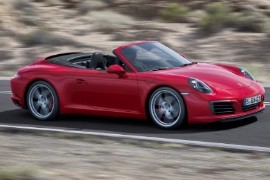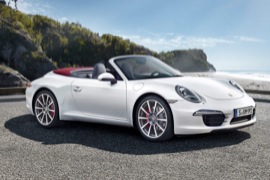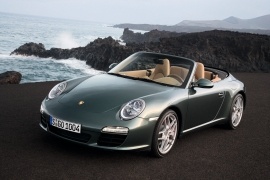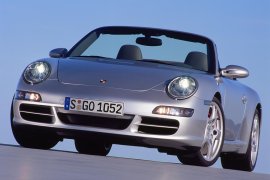PORSCHE 911 Carrera S Cabriolet Models/Series Timeline, Specifications & Photos
First production year: 2005
Engines: Gasoline
Body style: Convertible (spider/spyder, cabrio/cabriolet, drop/open/soft top)
In 2015 the Porsche Carrera S Cabriolet has received few updates, along with the rest of its siblings in the 911 family. But it managed to remain the same everyday supercar.
It was that daily-driver supercar that could take its top off in 13 seconds and run away with its 420 hp transferred to the rear wheels via a standard 7-speed manual gearbox. And it could do that many times without breaking a sweat.
The 2015 Carrera S Cabriolet had the same wider rear track when compared to the non-S version of the vehicle. It wasn't something everyone would notice, but the difference was there for a reason, and that reason was the wider tires installed. From behind, a rear red light-strip united the LED taillights.
Inside the Carrera S Cabriolet, there were some luxury features. The leather-covered sport-bucket seats were covered in leather. Even the rear, unusable, seats were wrapped in leather. The center console was higher to give the driver a sense of a single-seat racing roadster. On the console, there were the buttons for adaptive suspension and other technical features of the vehicle plus the gearshift lever.
Porsche offered a 7-speed manual as standard or a 7-speed dual-clutch PDK system for the transmission. The 7-speed manual had an interesting feature that prevents the driver to accidentally downshift from 7th to 4th, which could damage the engine, or upshift if it wasn't in the 5th or 6th gear. For the 2015 model, the Carrera S received a new torque-vectoring system that aided the traction on the corners.
The Porsche's 911 roots started in 1963 and it continuously evolved ever since. It grew in size, engine, and power. It evolved from a sports car to a luxurious super-car. And the 2012 Carrera S Cabriolet was no exception.
The seventh generation of the 911 was launched in 2012 and it sat on a new platform, with a longer wheelbase and shorter overhangs. It also featured new headlights and taillights. The overall shape of the car didn't change that much since 1963 and that is one element why the 911 became an iconic car, same as the VW Beetle and the Land Rover Defender.
The round headlights with the white DRLs strips underneath, installed on the bumper were one key-feature of the 2012 Porsche 911. The three air-scoops in the bumper amplified the sport look of the vehicle. Even in the convertible version, the seventh Porsche 911 kept its original shape. On top of the engine lid, there was an active wing that was risen on highway speeds to keep the car better planted on the road. Porsche stated that the wing was tested up to 300 kph (186 mph) and the car had zero lift.
Inside, the Carrera S Cabriolet was fitted with comfort features and with a choice of seats, but all of them were sport-oriented with bolstering on the outside. For the infotainment unit, Porsche installed the PCM (Porsche Communication Management), with iOS compatibility. For Android users, the car-manufacturer offered a special application. The power-roof could open or close the top in 20 seconds at speeds up to 50 kph (31 mph).
The 2012 Porsche Carrera S Cabriolet featured a 3.8-liter flat-six engine. It was mated as standard to a seven-speed manual transmission. An automatic, PDK (dual-clutch) transmission was offered as an option.
In 2008 facelift for the Porsche 911 – 997, also known as the 997.2, was a serious improvement over the 2004 model. It brought changes in all departments: from the exterior to the engine.
After four years into production, a mid-life cycle refresh was ready for the market. Porsche had to improve its engines to make them cleaner and to respect the new pollution norms in Europe. It meant that it had to build its cars more fuel-efficient. As usual, the rest of the car suffered some minor changes as well.
On the outside, the first difference was on the front bumper, where larger air-intakes were sculptured. The headlights were fitted with bi-xenon lamps while the running lights and taillights were fitted with LEDs as standard. A new design for the door mirrors was adopted.
As any premium or sports convertible, the Carrera S Cabriolet featured a power-roof, which could cover and uncover the car in 20 seconds. The interior featured a new PCM (Porsche Communication Management), which supported the Apple CarPlay. For Android users, there was an app to download, but it didn't work as well as the iOS systems.
The Carrera S Cabriolet featured a 3.8-liter engine that cranked up 385 hp, It was mated as standard to a 6-speed manual and a 7-speed automatic PDK (dual-clutch) was on the options list. The PASM (Porsche Active Suspension Management) was fitted as standard.
The Carrera S convertible was introduced to the market at the same time with the Carrera Cabriolet, a few months after their coupe-versions were unveiled.
The 996 generation was the first to feature water-cooled engines and it was not such a big success as expected. Porsche fans, especially, didn't enjoy it too much so, the introduction of the 997 generation in 2004 was very important for the German sports-car maker.
The convertible version for both Carrera and Carrera S was developed at the same time with the coupe. Thus, the engineers installed on the coupe some reinforcements needed for the cabriolet. As usual, most of the body parts from the open-top version were carried-over from the coupe. The platform was strengthened to act as a chassis. The convertible was only seven kilograms (15.4lbs) heavier than the coupe, which made it as fast as the closed-version. At the back, the rear wing was extended 20 mm (0.79”) more than the spoiler on the coupe, and that helped the Carrera S achieve the same top speed as a convertible or as a coupe: 293 kph (182 mph).
Inside, the Carrera Cabrio featured the same options as the coupe, plus the wind deflector. That allowed a normal conversation even with the top down at highway speed. To cover or uncover the car, the electric system needed only 20 seconds at speeds up to 50 kph (31 mph).
For the engine compartment, the 911 Carrera S Cabriolet 997 was fitted with a 3.8-liter flat-six that offered 355 hp. It was paired as standard to a 6-speed manual, while a 5-speed automatic with manual override (Tiptronic S) was offered as an option. The Porsche Stability Management was a standard fit for both Carrera and Carrera S Cabriolet.



